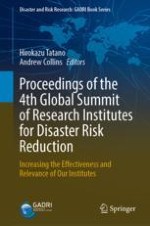2023 | OriginalPaper | Buchkapitel
Harnessing Scientific Knowledge and Technological Innovation for Disaster Risk Reduction (DRR) in Sub-Saharan Africa-Case of Social Media
Aktivieren Sie unsere intelligente Suche, um passende Fachinhalte oder Patente zu finden.
Wählen Sie Textabschnitte aus um mit Künstlicher Intelligenz passenden Patente zu finden. powered by
Markieren Sie Textabschnitte, um KI-gestützt weitere passende Inhalte zu finden. powered by
The biggest challenge to disaster risk reduction (DRR) in Sub-Saharan Africa is being presented by climate change due to the continent’s acute vulnerability inherent in multiple stresses and low adaptive capacity. It is common knowledge that the task of managing disaster risks and disaster events is heavily dependent on scientific knowledge and evidence-based technique which doubles up as a pillar for investment in DRR and used as a basis for formulating disaster risk management techniques. In this way, the application of science and technology has the potential to substantially reduce losses of lives and property. The current Intergovernmental Panel on Climate Change special report (AR6) on managing the risk of extreme events and disasters thoroughly interrogates this aspect and provides the essential evidence base. Equally important is to note that climate change appreciation and discourse demands high scientific standards. As such, its acceptance and readiness to move to reduce its impacts through DRR techniques requires much more systematic and proven sets of data, methods and tools and much stronger scientific and technical support capacities than is the case at present in Sub-Saharan Africa. The Sendai Framework for DRR 2015–2030 (SFDRR) sent clear signals to the mandate of science, technology, and innovation in driving government activities that is based on developing and sharing the knowledge and solutions needed to improve the resilience of communities. As such, there is need to harness the new global scientific challenges to DRR if Sub-Saharan Africa is to remain afloat in the DRR framework. Fortunately, the current science and technology advances have reached levels where a global village has been created which makes available more than ever before, immeasurable amounts of information relevant to DRR through a simple mouse click. In this way, more actors from different disciplines and policy areas can harness the emerging scientific challenges for the enhancement of DRR in Sub-Saharan Africa. This paper is predominantly concerned with how disaster risks and losses in Sub-Saharan Africa can be further reduced through harnessing science and technology innovation in the case of Social Media.
